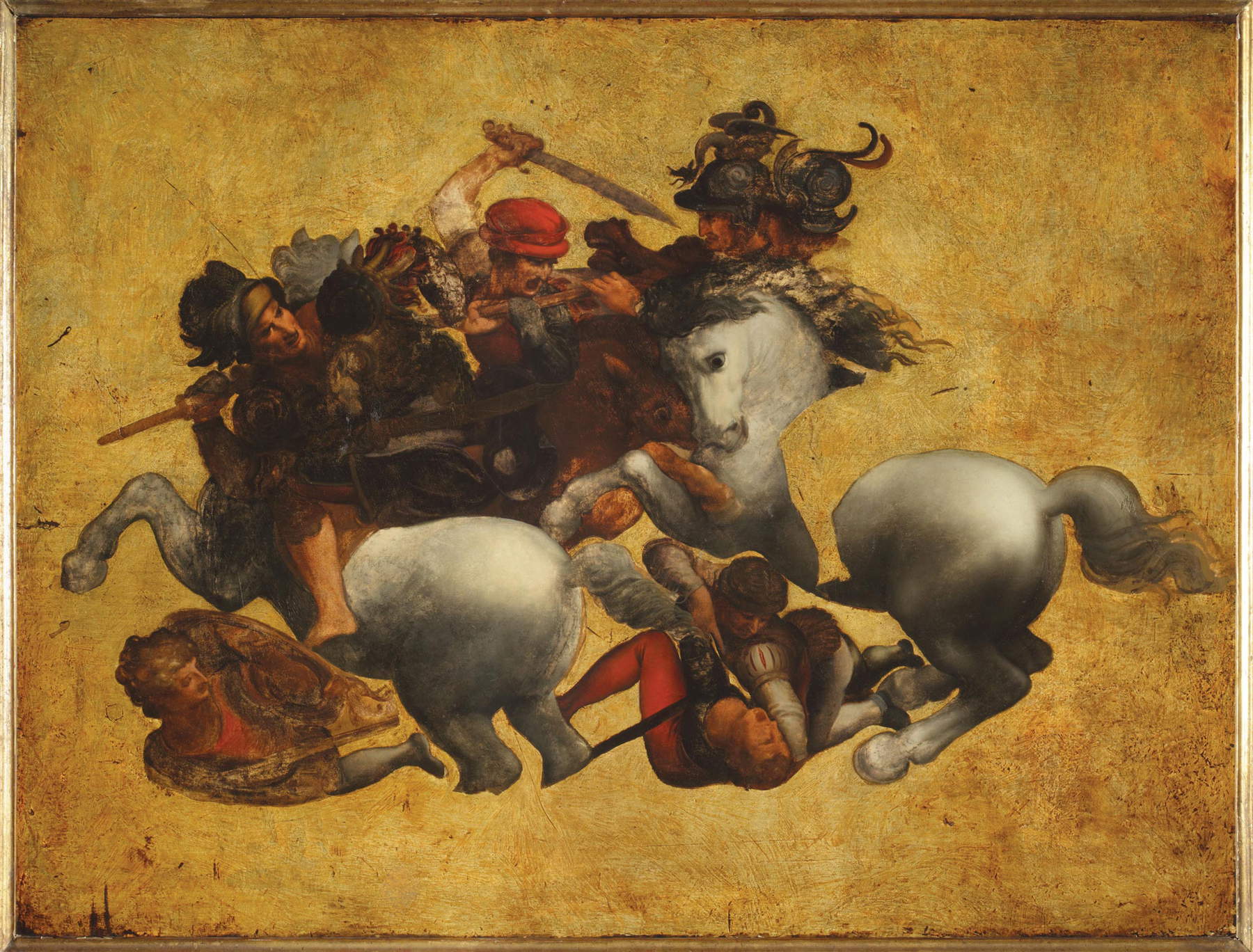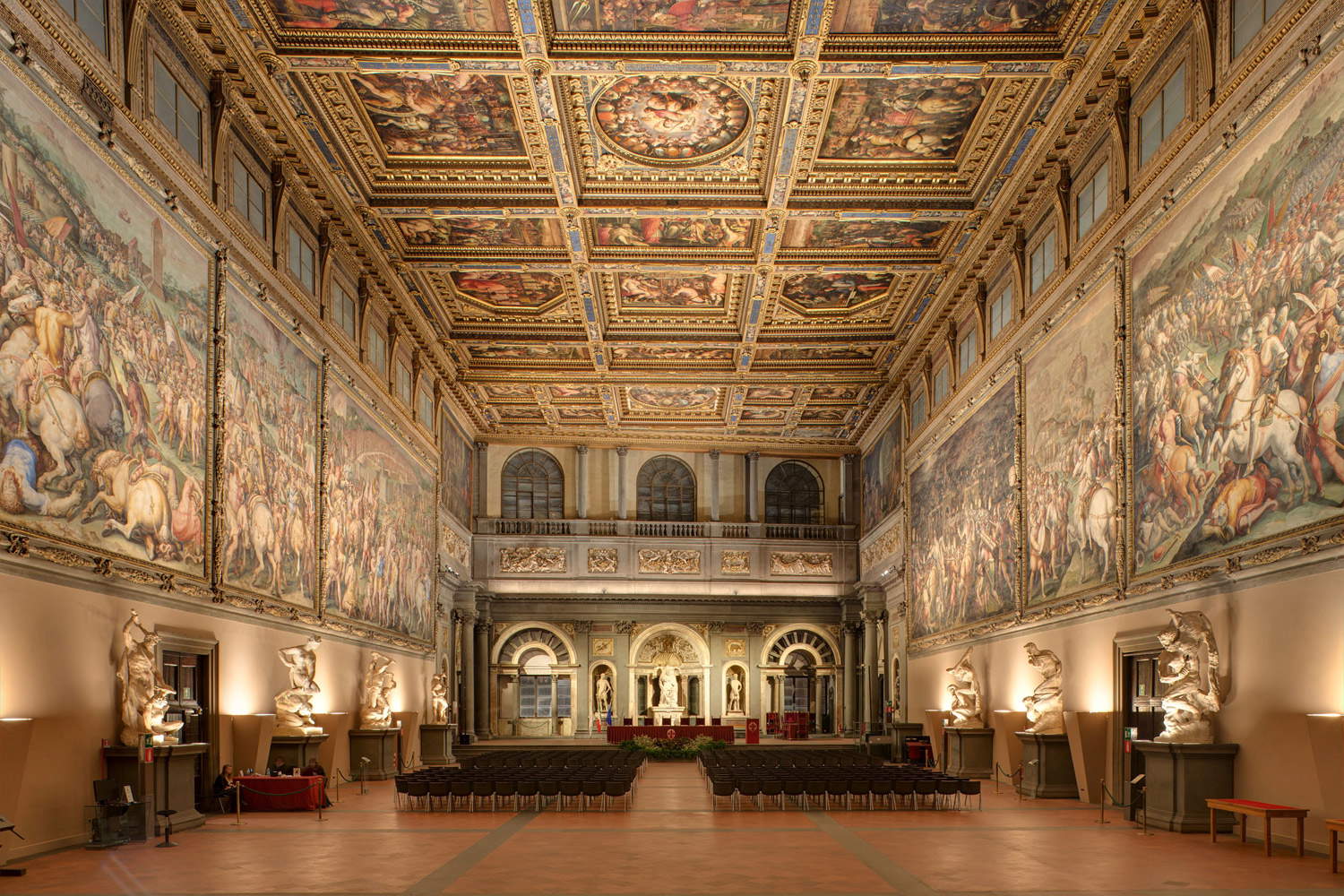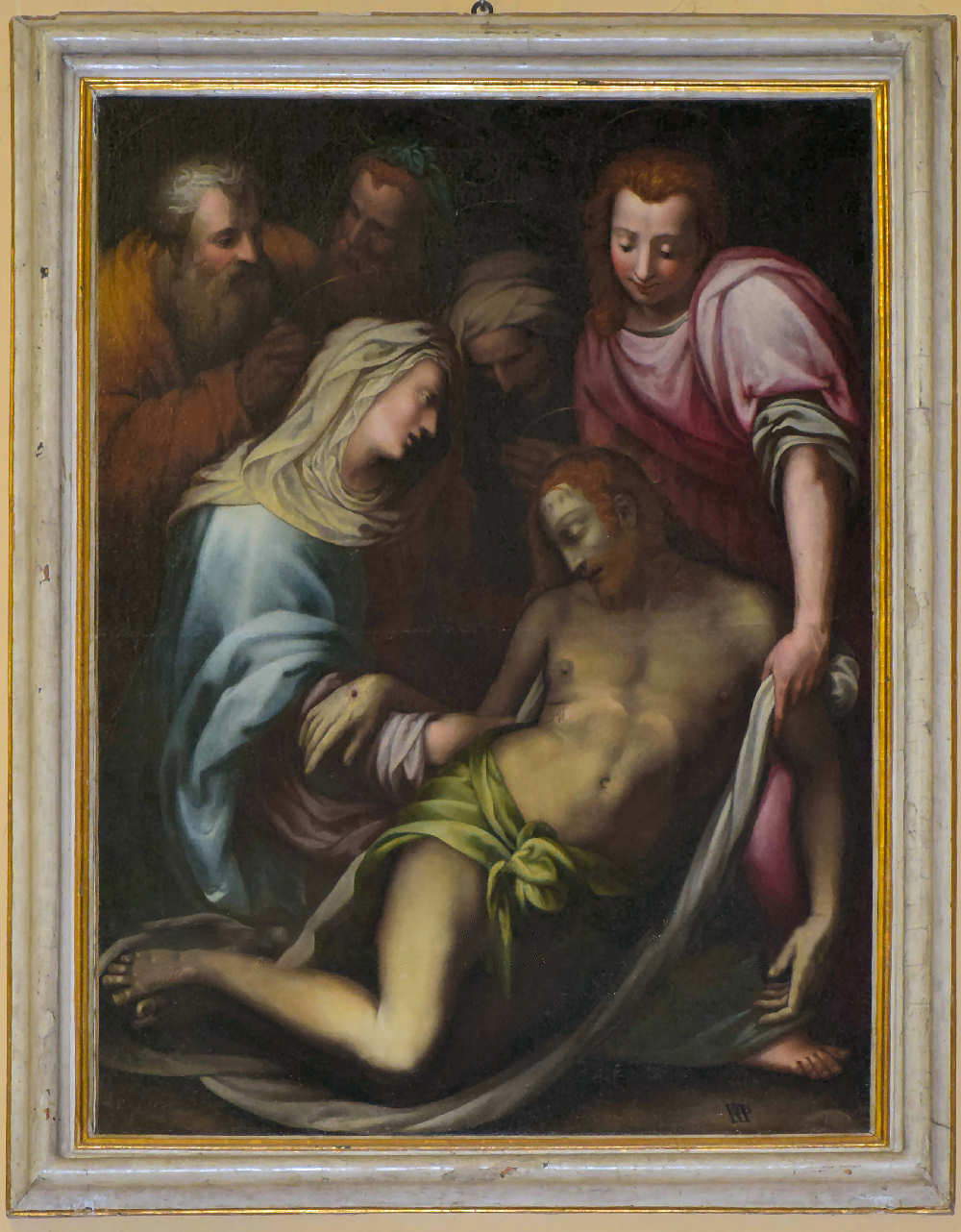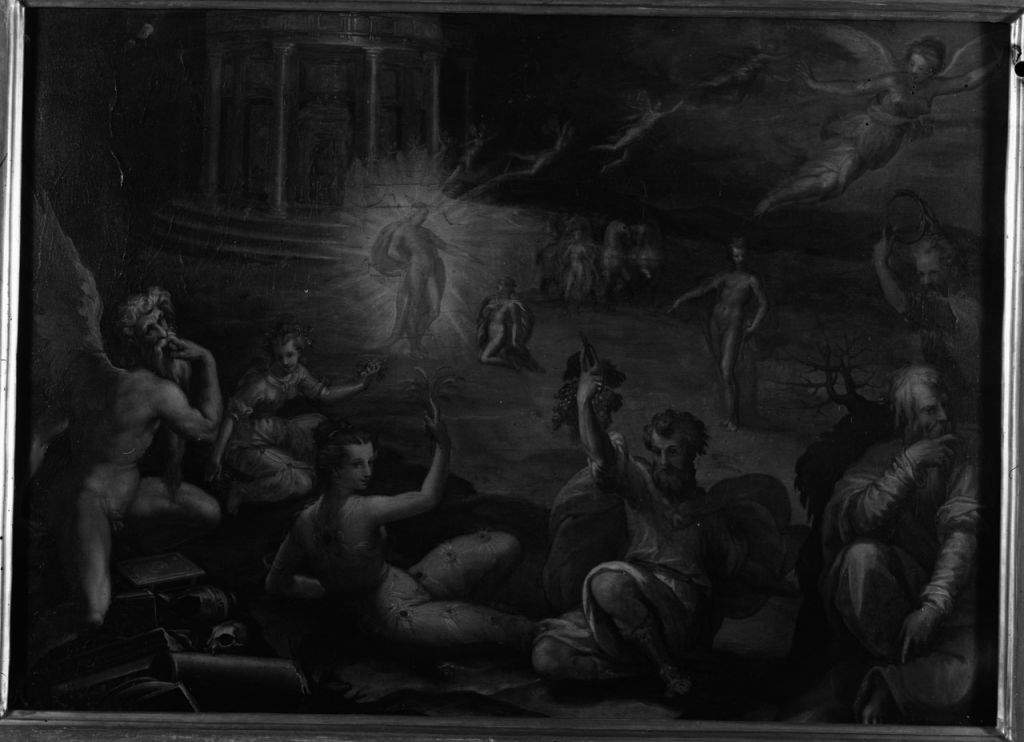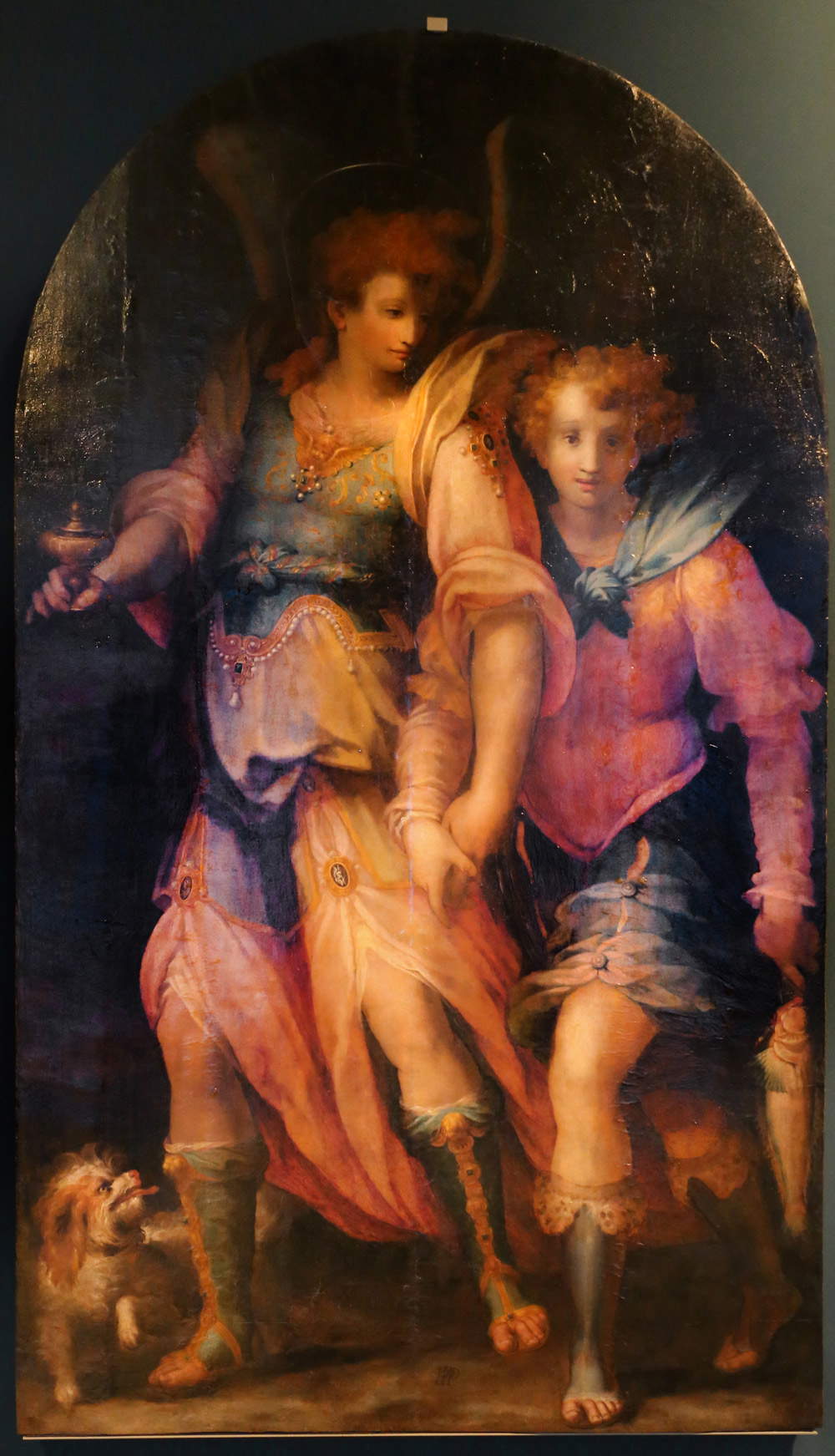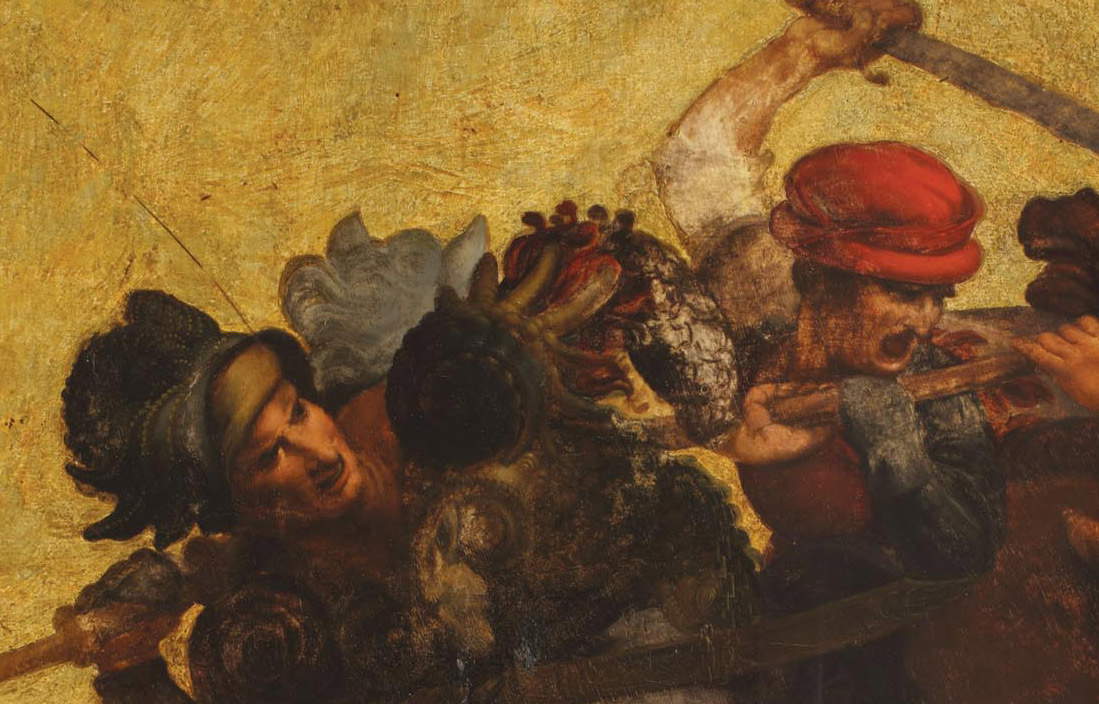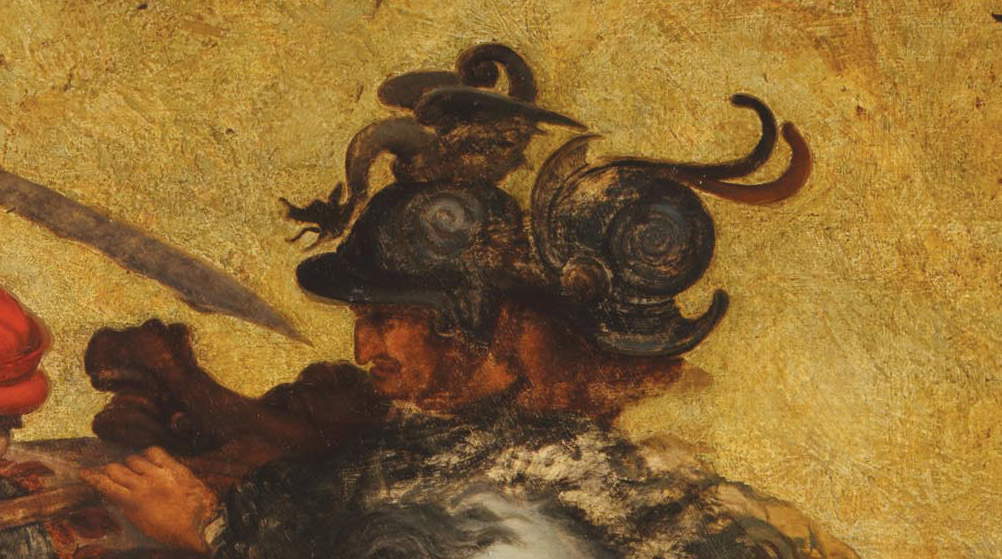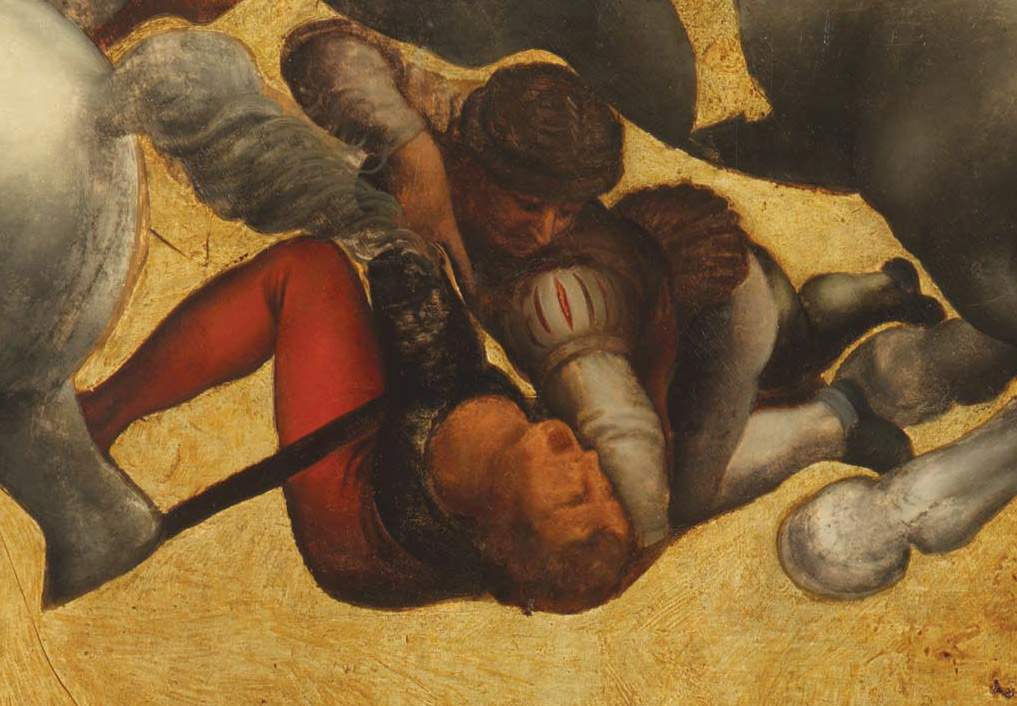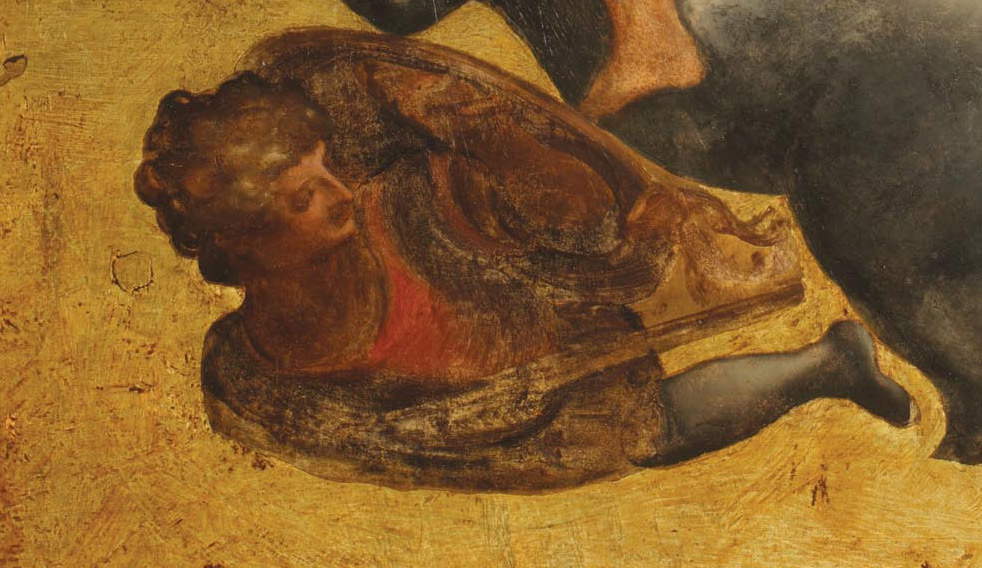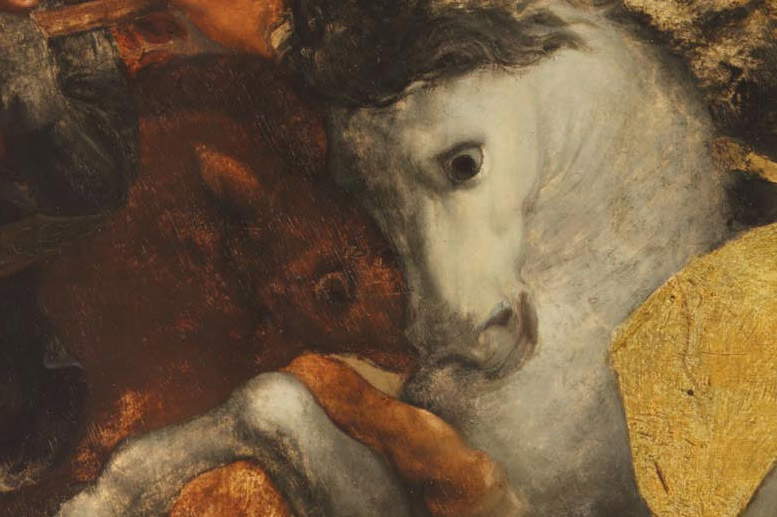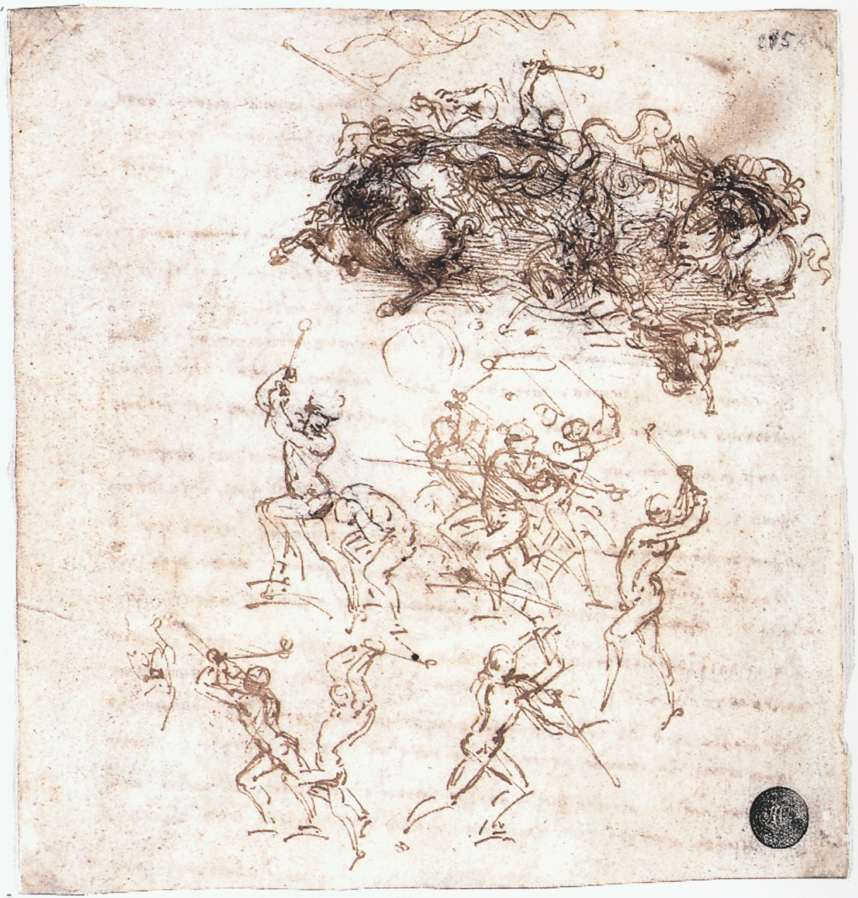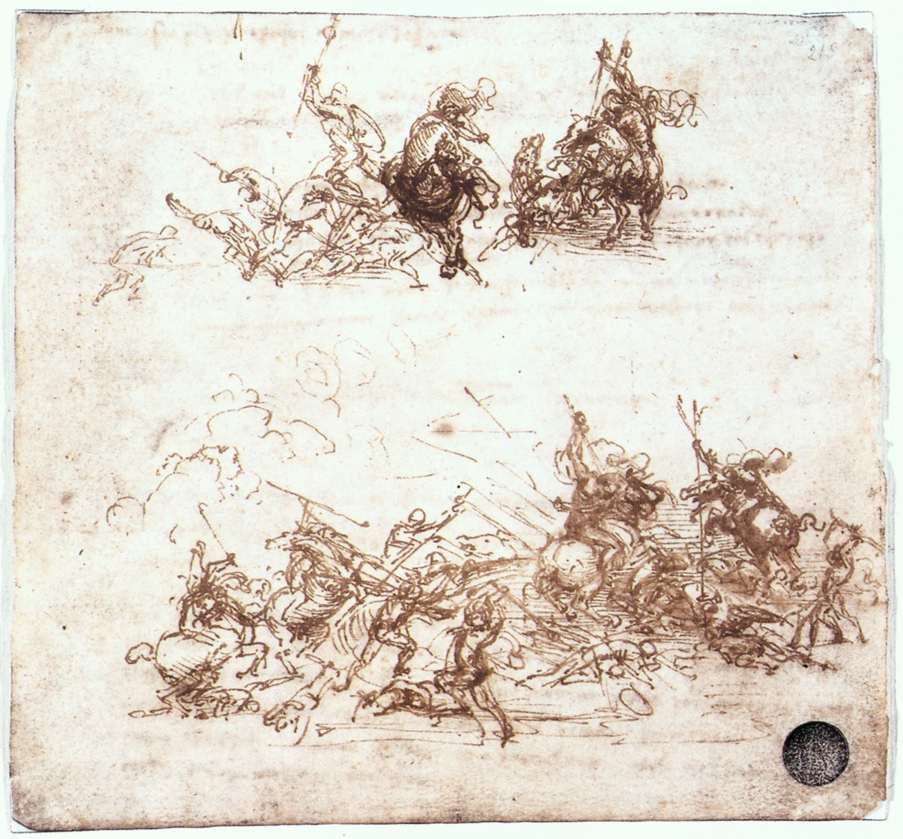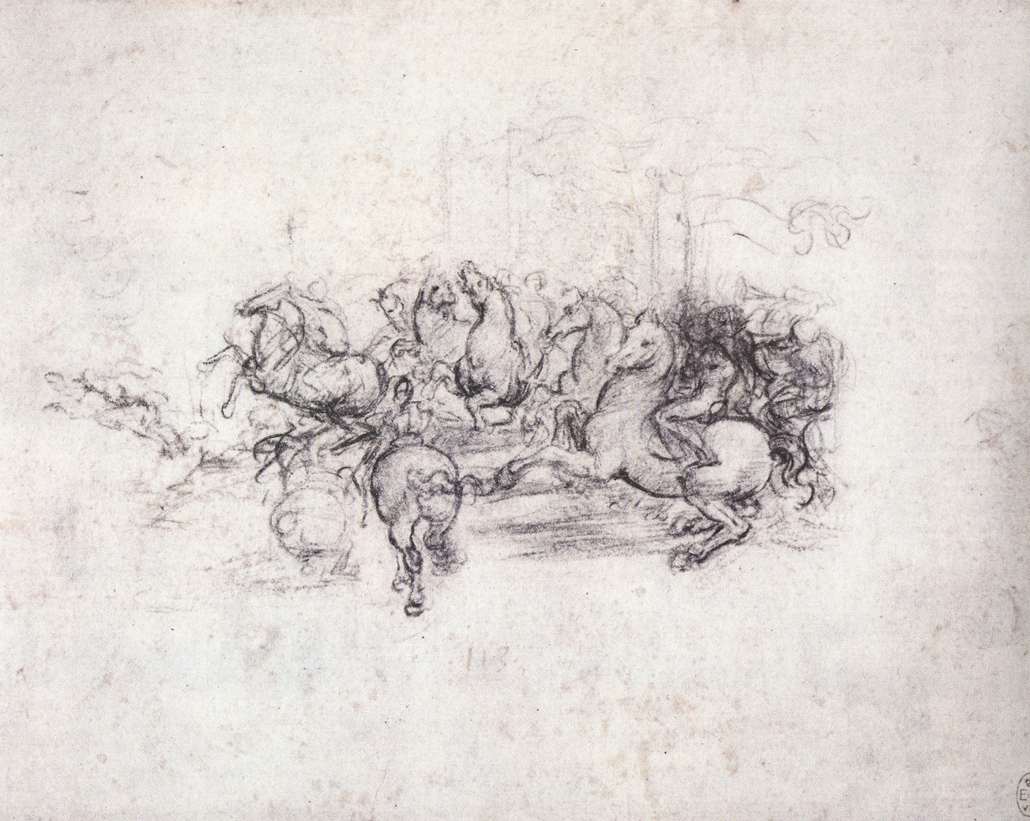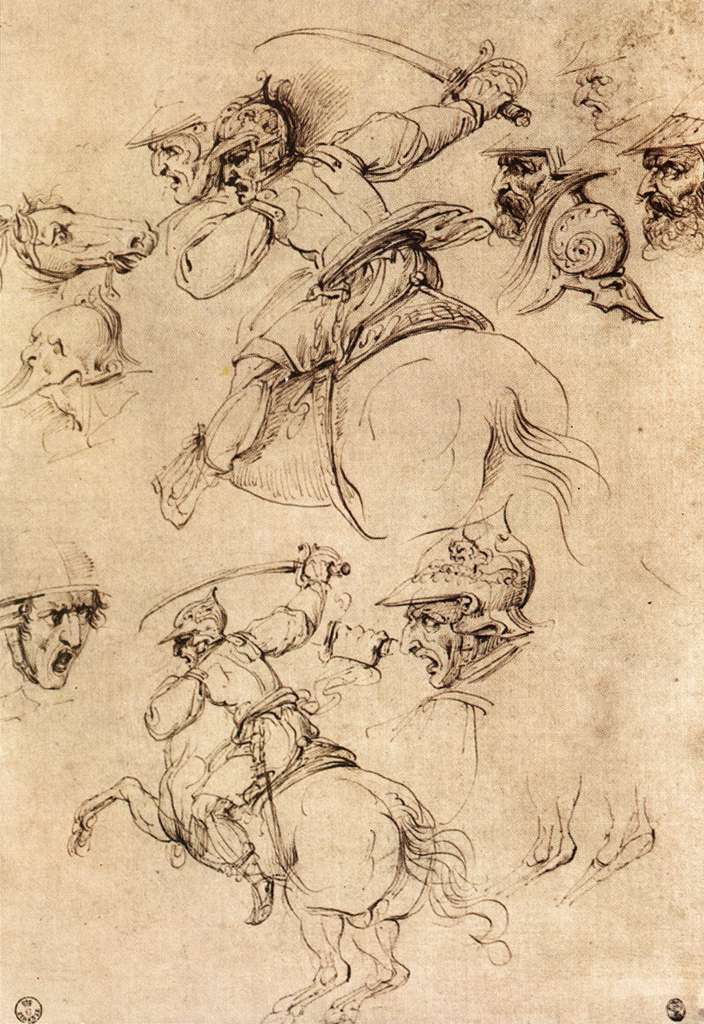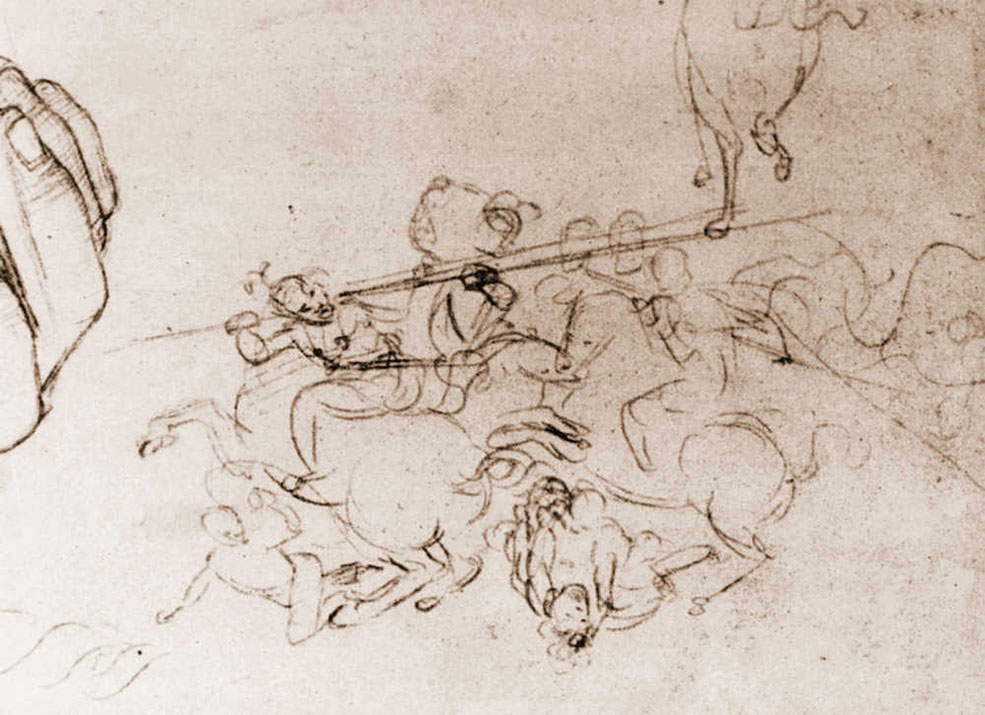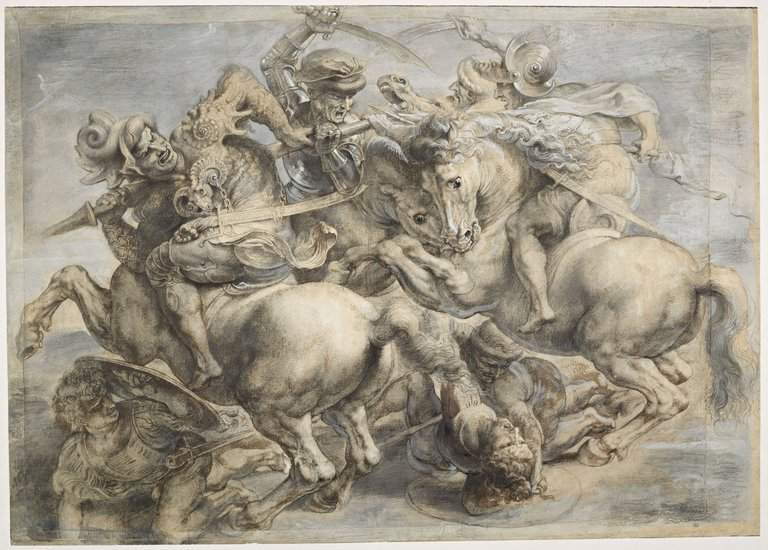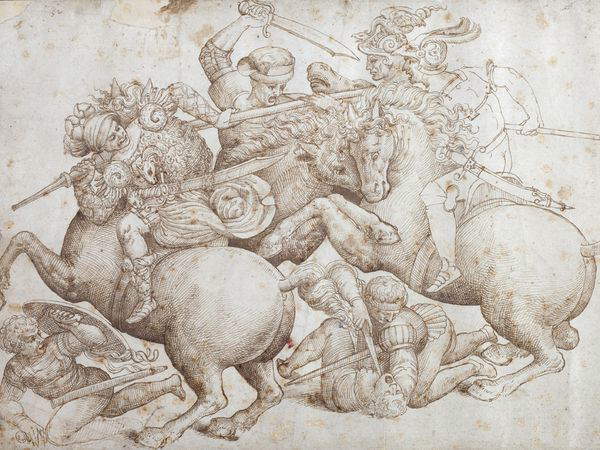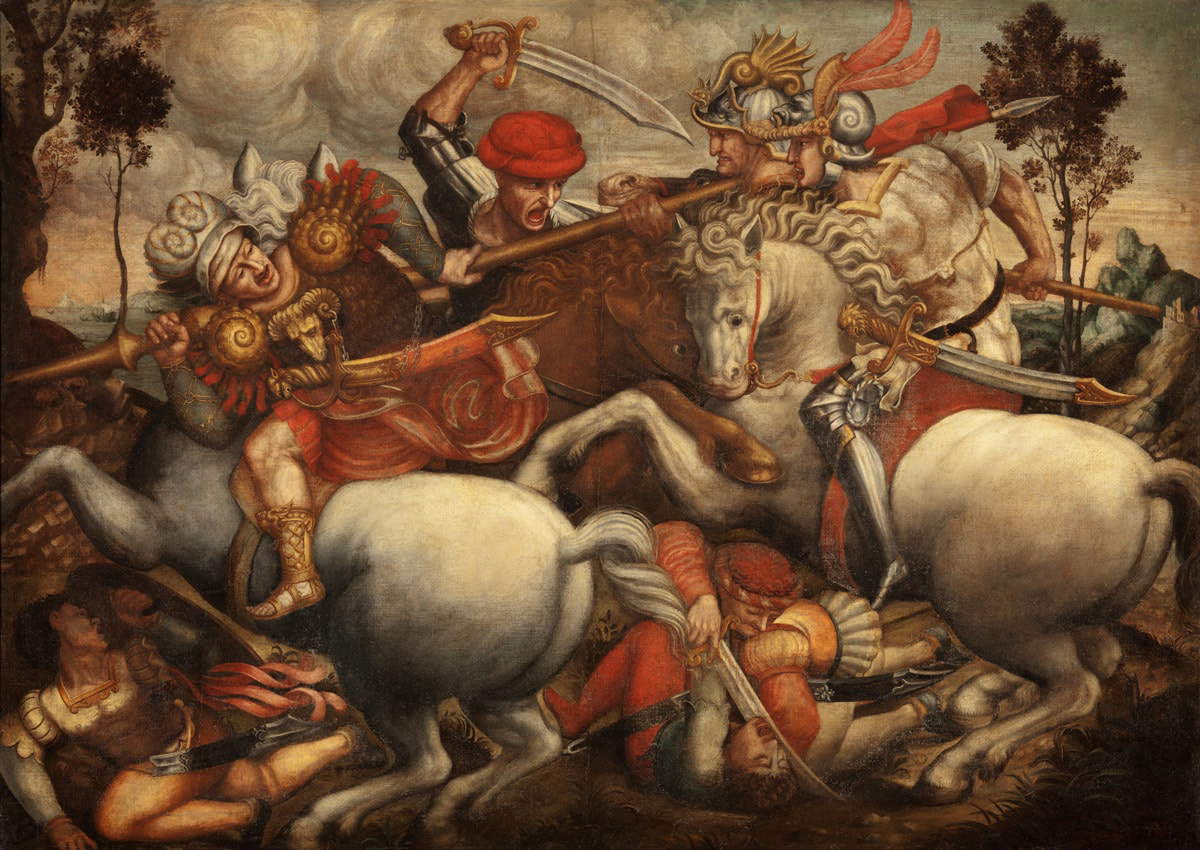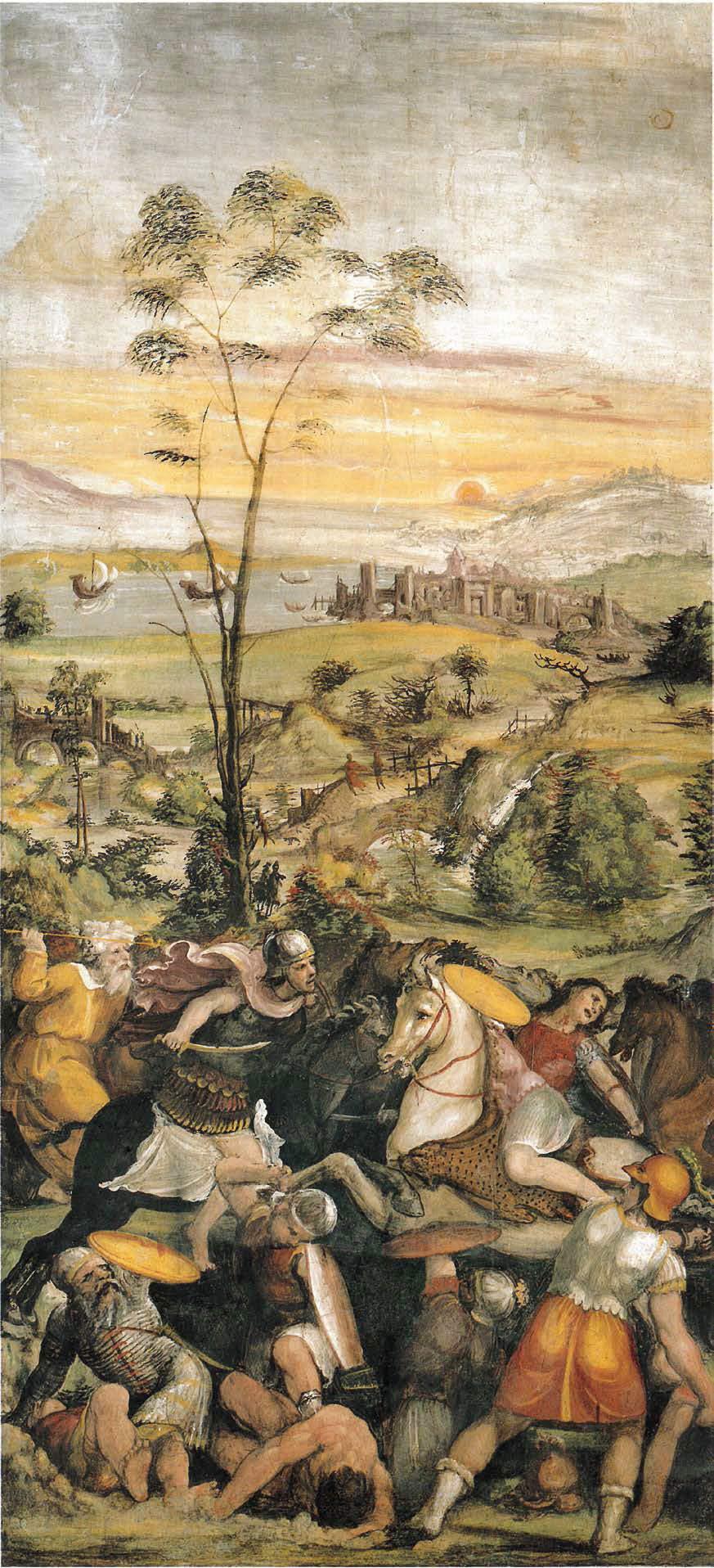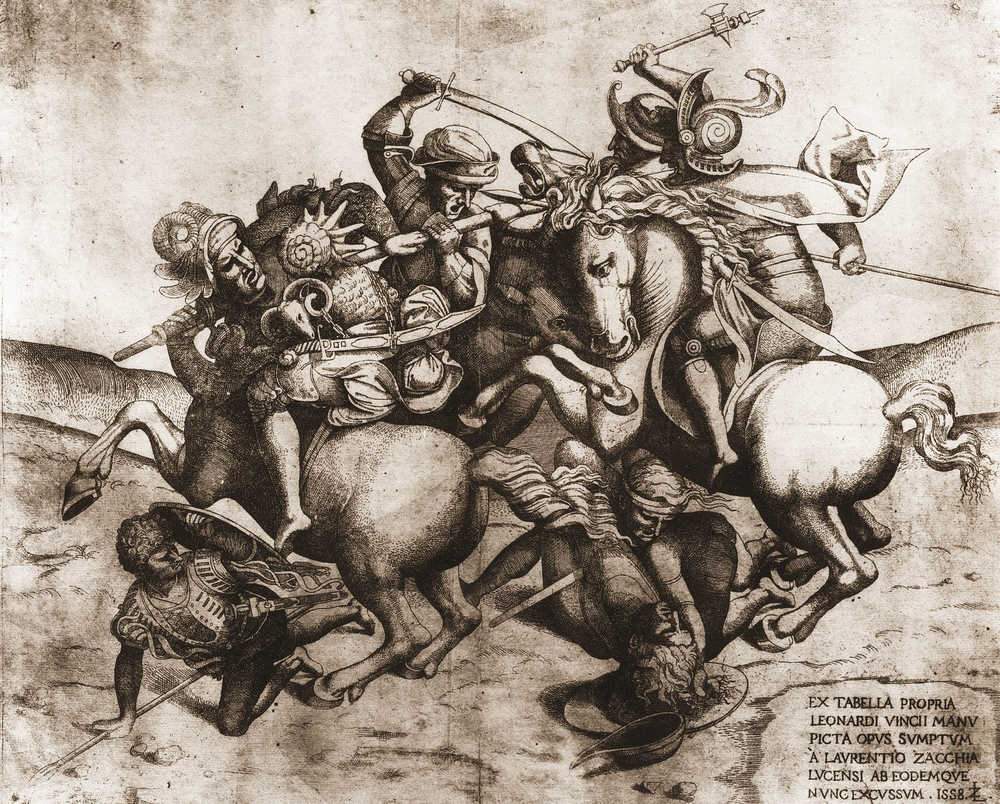by Federico Giannini, Ilaria Baratta , published on 13/09/2019
Categories: Works and artists
- Quaderni di viaggio / Disclaimer
The Doria Table is surely the best known and most discussed (and also the best) of Leonardo da Vinci's copies of the Battle of Anghiari. Let's take a closer look at it.
On June 12, 2012, the secretary-general of the Ministry of Cultural Heritage, Antonia Pasqua Recchia, and the director of the Tokyo Fuji Art Musueum, Akira Gokita, signed an agreement thanks to which Italy would regain possession of a precious 16th-century painting, universally known as the Tavola Doria, a direct testimony to the lost Battle of Anghiari by Leonardo da Vinci (Vinci, 1452 - Amboise, 1519). The agreement signed between the two countries stipulated that the work would be returned to Italy, which would become its exclusive owner, and that it would be exhibited alternately between the two countries for twenty-six years (two years in Italy, four in Japan): at the end of this long span of time, the panel would return permanently to Italy. To understand how the agreement was arrived at, it is necessary to trace the recent history of the work and go back to 1940, when the collection of its owner, Prince Marcantonio Doria, was auctioned at Palazzo d’Angri in Naples. The work, notified by the ministry (and thus prevented from leaving Italy), was purchased by another nobleman, Marquis Giovanni Niccolò De Ferrari, from Genoa, who disappeared, however, in 1942: the heirs sold the Doria Table to the Florentine antiquarian Ciardiello, and somehow the work became the object of an illegal purchase by a Swiss dealer, Antonio Fasciani, who in 1962 resold it to a company in Munich, Interkunst GmbH. In 1970 the work is mortgaged and seventeen years later the painting is sold to a German consulting firm, which in 1992, in turn, sells it to the Tokyo Fuji Art Museum for a sum equivalent to about thirty million euros today. A short time passes, however, and the Japanese museum realizes that the work has illegally left Italy: the panel is brought to Europe because Japan intends to subject it to some examinations, and in 2009 Italy learns that the Japanese museum has purchased it. The Carabinieri’s Nucleo Tutela Patrimonio Culturale located the Tavola Doria in a vault in Switzerland: a negotiation with Japan (the museum had purchased the work in good faith) was therefore initiated, culminating in the 2012 agreement.
The Tavola Doria was assigned to the Uffizi Gallery, but when it is in Italy it is regularly loaned for temporary exhibitions: in 2019, for example, the painting is among the protagonists of the exhibition Arte di Governo a la Battaglia di Anghiari. From Leonardo da Vinci to the Uffizi’s Jovian Series (curated by Gabriele Mazzi and staged in Anghiari at the Museo della Battaglia from September 1, 2019 to January 12, 2020), which provided an opportunity to retrace the studies that a great Leonardo scholar, Carlo Pedretti, devoted to the panel. As art historian Margherita Melani recalls in her essay, Pedretti, in 1968, was the first scholar to publish color images of the Tavola Doria: at the time, the painting was in Munich. Three years earlier, another art historian, Giorgio Nicodemi, had informed him of the presence in Germany of “a memory of the Battle of Anghiari.” The following year, Nicodemi again wrote a letter to Pedretti informing him of his desire to publish an extensive study of the Tavola Doria (a purpose that was interrupted, however, by the scholar’s sudden death on June 6, 1967). Pedretti therefore took on the task of studying the painting in depth and began exchanging correspondence with the owner of the panel, Mr. Georg Hoffmann, owner of Interkunst GmbH. This correspondence, Melani points out, "clearly shows Pedretti’s attention to all the problems related to the lost Battaglia di Anghiari“: Pedretti intended, in fact, not only to reconstruct the history of the panel with dozens of details, but also ”to do specific research,“ Melani again writes, ”in the Salone del Gran Consiglio in Palazzo Vecchio with the conviction, never abandoned, that he would be able to find at least part of Leonardo’s original painting.“ Pedretti therefore began ”to move on two fronts: to try to initiate an ambitious research project involving the detachment of Vasari’s frescoes by trying to mobilize public opinion through a popular article to be published in the famous American magazine Life and, at the same time, to point out the Doria to scholars with an article to be published in the pages of LArte." The project of detaching Vasari’s frescoes did not go through (it would be proposed again almost fifty years later by others, but even in the latter case, beyond a few holes in Vasari’s frescoes, fortunately it went no further), but the study continued.
In the meantime Hoffmann’s financial situation had deteriorated very badly, and the Tavola Doria was seized from him: moreover, in 1982, the Superintendency of Naples reported, to general astonishment, that the work had illegally left Italy. The news came at a time when Pedretti was planning an exhibition on the Battle of Anghiari, as part of which the Tavola Doria would play a major role (a purpose that would later not be followed up). Pedretti has also long been involved in the attribution debate: in the past he assigned it to the young Raphael and later also to Leonardo himself (believing it to be a preparatory oil sketch made before painting on the wall: in the case, it would have been a more unique than rare event, since the use of executing oil sketches before wall painting only became widespread in the seventeenth century), and then settled on an open position that did not go out of its way to name names (in 2014, in an essay entitled “Farewell” to the Tavola Doria, the scholar wrote: “I no longer pose the problem of attribution as I did in the days of great and motivated enthusiasm - we are talking about thirty or forty years ago , with outbursts of Garibaldian emphasis, when it was customary to start in the fourth gear with attributions to Leonardo without embarrassment and without qualms, and without even posing at least the alternative of the name of one of the best pupils to whom Leonardo would have entrusted demanding atelier tasks according to a practice that Raphael would apply shortly after”).
 |
| Francesco Morandini known as Poppi (?), Tavola Doria (1563?; oil on panel, 86 x 115 cm; Florence, Uffizi Galleries) |
 |
| The Salone dei Cinquecento in the Palazzo Vecchio in Florence. Ph. Credit Targetti Sankey |
And indeed the debate over who might be the author of the Tavola Doria has been long and complex. Many have insisted on the possible Leonardo autography, being able to rely on several clues, first and foremost the fact that in the oldest document that mentions it, an inventory of the collections of the Doria family (its former owners, hence the name) dating back to 1621, the work is mentioned as “a battle of soldiers on horseback by Leonardo da Vinci” (and later, in Marco Antonio Doria’s will of 1651, a “groppo de’ cavalli di Leonardo da Vinci” is mentioned). Of course, in themselves two seventeenth-century documents say little, but those who in the past supported an attribution to Leonardo appealed to other elements, all summarized by Mediterranean civilization scholar Louis Godart in his 2012 book The Doria Table: e.g., the pentimenti in the preparatory drawing (which often, though not always, make one dismiss the possibility that it is a copy), the zig-zag stroke that appears on the horse’s temple and recurs in several of Leonardo’s graphic works, the known existence of a painting depicting the Battle of Anghiari executed while the artist was working in the Sala del Papa in Santa Maria Novella, the fact that several known copies of the Battle of Anghiari derive from the Tavola Doria, and again the presence of elements that reproduce with great accuracy Leonardo da Vinci’s sketches and notes. Details that in themselves do not rule out the hypothesis that the work may be a product of Leonardo’s hand, but neither can they support it.
In this sense, the most recent in-depth study (dating back to 2018) is that of U.S. art historian Louis Alexander Waldman, who has rejected any hypothesis about Leonardo’s autography (even with some irony: “the inexhaustible optimism of the so-called Leonardists, so often accompanied by a complete lack of self-critical spirit,” he wrote, “is a disease for which modern science has not yet found a cure”). To try to figure out who the author of the Doria Table might be, Waldman turned his attention to a “sister” work: a painting, likely from the same period, that similarly reproduces the central part of the Battle of Anghiari. This is another panel painting, dating from around 1563, preserved in Florence’s Palazzo Vecchio (on deposit from the Uffizi, in whose collections its presence has been recorded since 1635, the year to which an inventory dates in which the painting is cited as a work by Leonardo). A little larger than the Tavola Doria (and thus the latter may be a preparatory study of it according to Waldman), the Battaglia di Anghiari from the Uffizi deposits, Waldman points out, “is unique among the extant copies in that it renders the subtle gradation of tone in the untitled area of Leonardo’s model, corresponding to the profile of the horseman on the white horse at the far right of the composition; it also includes detailed indications of the fragmentary profiles omitted by other earlier copyists and which are only hinted at in the Tavola Doria.” This is a painting whose finish is so high as to indicate that, in all likelihood, its author worked directly on the original cartoon before its destruction (and especially before Vasari began decorating the Salone dei Cinquecento, i.e., beginning in 1563). Waldman himself had proposed attributing this copy of the Battle of Anghiari to Francesco Morandini known as Poppi (Poppi, 1544 - Florence, 1597), one of the leading artists of the second half of the 16th century in Tuscany.
The American scholar noted in the two works reproducing the battle (thus also in the Tavola Doria) some of the characteristics of Poppi’s manner: “the pearly splendor of the modeled forms, the liquid sheen of the brushstroke, and (irrefutable signs of the artist’s hand) the stylization of Leonardo’s naturalistic faces into cold mannerist masks, which bear the signature of the young Casentino painter: painted with indifferent and detached expressions, while giving the flesh fresh and ruby tones.” And again, “in both panels [...] the same chiseled faces recur, with blocked features, resembling elegant and graceful masks, with a dull, reddish complexion, according to the custom of the Casentino painter.” Elements that, Waldman pointed out, can be found precisely in some of Francesco Morandini’s works: for example, in the canvas with the Lamentation over the Dead Christ preserved in his hometown (the face of St. John resembling that of Francesco Piccinino, the first horseman on the left, as will be seen later), or in the work The House of the Sun preserved in the Casa Vasari Museum in Arezzo (the way the arms are painted), or again in Tobias and Raphael in the Museum of Palazzo Pretorio in Prato (the characteristic elongated figures). It is, moreover, well known that Poppi was, in his youth, a prolific copyist: it should therefore come as no surprise that he also copied Leonardo da Vinci’s famous mural. There is then a further interesting circumstance: Morandini was among the artists who collaborated with Vasari in the creation of the frescoes in the Salone dei Cinquecento between 1563 and 1570, and it can therefore be assumed that the artist copied Leonardo’s work in the context of this important undertaking. However, the two panels are copies subject to the interpretation of their author (in the Doria Table, for example, there is a soldier on the left with a shield on the ground, absent in the Palazzo Vecchio panel) who, Waldman concludes, we must imagine as “the last painter who set out to copy a masterpiece by Leonardo.” and to whom we must be grateful “for what he saw and diligently copied with such sensitivity and attention to detail, while infusing the two panels with the vivid imprint of his graceful and elegant late 16th-century mannerism.” The attribution to Poppi has already won acclaim: for example, at the same Anghiari exhibition the work was exhibited with just such an attribution, albeit marked with a question mark.
 |
| Francesco Morandini known as Poppi (?), Struggle for the Standard, copy of Leonardo da Vinci’s Battle of Anghiari (1563?; oil on panel, 83 x 144 cm; Florence, Palazzo Vecchio, on deposit from the Uffizi Galleries) |
 |
| Francesco Morandini known as Poppi, Lamentation over the Dead Christ (c. 1580-1590; oil on canvas, 140 x 100 cm; Poppi, Prepositura di San Marco) |
 |
| Francesco Morandini known as Poppi, The House of the Sun (third quarter of the 16th century; oil on panel, 54 x 61 cm; Arezzo, Casa Vasari) |
 |
| Francesco Morandini known as Poppi, Tobias and the Angel (1572-1573; oil sus panel, 215 x 130 cm; Prato, Museo Civico di Palazzo Pretorio). Ph. Credit Francesco Bini |
Although the hypothesis of Leonardo’s autography is no longer accepted, the Doria Table nevertheless remains a painting of considerable importance, and to understand it it is first necessary to know the history of the painted episode. Leonardo da Vinci’s original work dates to the period between 1503 and 1506: the Republic of Florence had decided to have the Salone dei Cinquecento in Palazzo Vecchio, the largest room in the building (54 meters long by 23 meters wide and 18 meters high: it housed the Grand Council of the Republic, a governing body, created at the time when Florence was ruled by Girolamo Savonarola, which consisted of five hundred members), with scenes of battles in which the Florentines were victorious: Michelangelo was commissioned to paint the Battle of Cascina, while Leonardo was responsible for the Battle of Anghiari. Neither project was finished-Michelangelo left it before completing it, while Leonardo abandoned it after failing to execute the painting on the salon wall. According to the version long believed to be the most likely, Leonardo would have wanted to experiment with theencaustic technique: instead of frescoing the wall, he would have painted it in oil on the already dry plaster, then allowed the paint to dry with the heat given off by two large wood-fired cauldrons. The account of theAnonymous Magliabechian states that “lower down the fire added and secluded [the painting, ed.], but up there at the top, because of the great distance, no heat was added and the matter dripped.” In essence, the room would have been so large that the heat was not enough to dry the top part of the painting, so the colors at the top would have dripped onto the bottom part, irreparably ruining the whole painting. However, recently a hypothesis by the scholar Roberto Bellucci has cast doubt on this version of events: the encaustic in fact involved the use of waxes, which with a source of direct heat would have melted, harming the work equally. The heat, according to what Pliny the Elder handed down in describing this technique, was, if anything, used to heat the support to promote the adhesion of the colors dissolved in wax. So, Bellucci points out, if Leonardo had used a similar technique, the heat would, if anything, have caused the part at the bottom to drip more than the part at the top, further from the fire. It is therefore more likely that the operation failed because of an incompatibility between the support and the colors, as the humanist Paolo Giovio (Como, 1483 - Florence, 1552) noted: “in the Council Chamber of the Florentine Signoria there remains a battle and victory over the Milanese, magnificent but unfortunate unfinished because of a defect in the plaster that rejected with singular obstinacy the colors dissolved in walnut oil.” In any case, it is certain that the failure convinced Leonardo to give up: it was in all likelihood the fall of 1505.
The Tavola Doria is one of the earliest copies of the Battle of Anghiari and depicts the central moment of the clash, the struggle for the standard, the Milanese banner contested by two knights from the Florentine army and two from the ranks of the Duchy of Milan, then ruled by Filippo Maria Visconti (Milan, 1392 - 1447). The events date back to June 29, 1440, and were part of the aggressive expansionist policy of the Milanese, who sought to expand their dominions in central Italy at the expense of neighboring powers: after losing Verona, reconquered by the Venetians (Milan’s enemies) and failing to take Brescia, the Milanese turned their sights to Romagna and Tuscany. Finding little resistance in Romagna, the Milanese army, led by the Umbrian mercenary captain Niccolò Piccinino (Perugia, 1386 - Milan, 1444), crossed the Apennines, sacked Mugello and took several villages, while Florence prepared for the clash and received aid from the Papal States, which in aid of the Florentine ally had sent its armies, led by the patriarch of Aquileia, Ludovico Scarampo Mezzarota (Venice, 1401 - Rome, 1465), prefect of the papal arms. The Florentine army, led by its commanding general, the Abruzzese nobleman Pietro Giampaolo Orsini, began to stand up to the Milanese and regained some of the forts it had lost, while meanwhile the army of Venice, also an ally of the Florentines, defeated the Milanese on the Lombard front at Soncino. As the situation was turning against the Milanese, the latter decided to retreat, but not before attempting to launch a last and massive attack on the Florentines. This occurred, as anticipated, at Anghiari on June 29, 1440, but the clash was won by the Florentines, who routed the Milanese army and succeeded in taking possession of their banner, as the chronicles of the time recount. Giusto d’Anghiari, a local notary who wrote a Diario that has been restudied on the occasion of the Anghiari exhibition, writes: “Thursday on the morning of June 30, the morning of the third, news came to Fiorenza of how our people, that is, of the Florentines, had broken hieri, which was the day of San Pieto, the camp of the Duke of Milan, that is, Niccolò Piccino, at Anghiari at the foot of the city towards the Borgo, and took from him about 3,000 cavalry and took 16 squad leaders and other men-at-arms a great deal and 1456 prisoners from the Borgo’s bounty, and other prisoners a great deal from other places. It was a great victory, and they took away their banners. Fecisene great feast, and deservedly so, because it was the health of Tuscany. Niccolò Piccino escaped with about 1,500 horses in lo Borgo, and the same night he fled and passed the Alps to his great harm and shame.” This was a decisive victory for the Florentines, since it sanctioned the end of the Milanese aims on central Italy.
The episode recounted by Leonardo is known only through copies: there are no longer original cartoons, nor complete drawings made by Leonardo (there are only studiesî of portions of the composition, which will be discussed below). From the copies we note that the scheme is more or less always the same: in the upper register we see the four main commanders of the two armies, who from left to right are Francesco Piccinino (Perugia, c. 1407 - Milan, 1449), son of Niccolò, at the head of the militia from Umbria, then his father Niccolò, and then, side by side, the commanders of the Florentine forces, namely Ludovico Scarampo Mezzarota and Pietro Giampaolo Orsini. The four are contending for the banner: the faces of the two Milanese captains are contracted into almost feral grimaces (and Francesco Piccinino is caught in a rather uncomfortable twist: he almost seems to be fleeing, and Leonardo probably wanted to allude to the flight to which the young condottiero gave himself in 1446 after being defeated by the Venetians at Mezzano, near the Po), while more calm, but still gritty and resolute, appear Scarampo and Orsini. Note also the decorations of the characters: the Milanese are negatively connoted, since Francesco Piccinino wears armor decorated with goat horns that allude to the devil (his father wears nothing but a beret, but his expression charged with violence and ferocity is enough in itself), while the opposite is the case for the condottieri of Florence, since Scarampo’s helmet is decorated with a dragon (according to art historian Frank Zöllner, who has long studied the Battle of Anghiari, it is a symbol of military valor but also of prudence), and Orsini’s recalls the helmet with visor and plume of the goddess Athena. Below, more soldiers: in the Tavola Doria we have one on the left, holding a shield, and in the center two furiously brawling with bare hands (alluding to the soldiery that, in the Renaissance, often followed the captains of fortune: poorly armed, if not downright unarmed, crude, animated by the basest and most boorish instincts, prone to crimes against property and against the person). In the center, the horses, also taking part in the battle: they look on, however, terrified, as if they want to disassociate themselves from the struggle to which their masters have forced them.
The aforementioned Godart emphasized the possible political message of the work: “Leonardo,” the scholar pointed out, "knew he had to make a work with a strong political impact. It was to show through the depiction of the Battle of Anghiari the triumph of a thoughtful Florence, strong in its rights and institutions, over an army of brutal and ruthless mercenaries. Well [...], the master has perfectly succeeded in his intent.“ An intent achieved on the one hand with a message related to the history of Florence: the enemies of the Republic who are portrayed as evil, violent, and horror-inducing men, and the Florentine condottieri who embody wisdom, intelligence, strategy, as well as the triumph of Florence’s institutions. On the other, Godart writes, ”an implacable denunciation of war." It is well known that Leonardo da Vinci, ahead of his time, had a very bad opinion of war: in his Treatise on Painting, the artist, in suggesting how to compose the foreshortenings of the human figure in battle scenes, wrote that “in the histories fanne in all the ways that happen to you, and most of all in battles, where by necessity happen infinite foreshortenings and bending of the composers of such discord, or you mean bestial madness.” And again, from the Corpus of Anatomical Studies: “think it to be a most nefarious thing to take the life of the man [...], and do not want your wrath or malignity to destroy so much life, that truly he who esteems it deserves it.” Leonardo, who tended to be a pacifist, thus considered war a “most bestial madness,” a contention proper more to animals than to men, which does not befit rational beings, and likewise deeply despised those who take someone else’s life: nevertheless, the painter considered war a necessary evil if what was at stake was the loss of freedom (the Ashburnham manuscript contains a fragment of a proem for a treatise on military art that was later never realized, and in which Leonardo writes that “in order to maintain the principal gift of nature, that is, freedom, I find ways to offend and defend in stando siege by li ambitious tyrants”: hence, his activity as a military engineer). With his Battle of Anghiari, Leonardo would have wanted to express a condemnation towards war, especially through the eyes of the two horses: “if the noble silhouettes of the horses contrast with the bestiality of the two condottieri in the service of Visconti and the two infantrymen facing each other in a deadly duel,” Godart reiterated, “it is above all the frightened eyes of the two animals that condemn the horror of the melee in which they were involved [...]. The eyes of Leonardo’s horses contemplating with revulsion the clash to the death involving them are the most effective of condemnations of any form of warfare.”
 |
| Details of the Doria Table: Francesco Piccinino and Niccolo Piccinino |
 |
| Details of the Doria Table: Ludovico Scarampo Mezzarota and Pietro Giampaolo Orsini |
 |
| Details of the Doria Table: the soldiers fighting on the ground |
 |
| Details of the Doria Table: the soldier with the shield |
 |
| Details of the Doria Table: the looks of the horses |
As mentioned, we have no complete drawings by Leonardo, but a few studies are preserved: in the Gallerie dell’Accademia in Venice there are a few drawings in which Leonardo studies the position of the horsemen and the composition of the melee (and the drawings show particularly crowded and violent scenes: in particular, in the Three Groups of Fighting Men we see how much Leonardo had focused on the brawl of the two men on the ground, unarmed, with the one on top trying to pierce his opponent’s eyes with his bare hands); at the Royal Library in Windsor, on the other hand, there is a black chalk drawing depicting some knights with banners; at the Uffizi there are some studies for the two knights on the right, while the Szépművészeti Múzeum in Budapest preserves a drawing for a study of a horseman’s head, and above all the most famous autograph study by the Da Vinci painter for the Battle of Anghiari, namely the study for the head of Niccolò Piccinino. The Budapest studies are particularly important: a leading expert on Leonardo da Vinci’s art, Carmen Bambach, believes they are among the last ones made for the heads before moving on to the final drafting of the painting, and she thinks the studies were conducted live. The artist, the expert points out, referring to the drawing of the Budapest head (which could be identified as a sketch for the figure of Pietro Giampaolo Orsini), “first traced the outlines of the head, roughly, then modeled the shadows with parallel strokes, with his characteristic way of drawing from the lower right corner to the upper left corner. Then he rubbed the strokes together to achieve an effect of continuity, and to reinforce the outlines he chalked quite hard with chalk on the paper.” However, it is clear from the drawings and copies (which all focus on the clash between the four condottieri) that this tussle was the central motif of Leonardo’s painting. “The copies that have come down to us,” Frank Zöllner has written, “confirm the supposition that the artist made neither on the preparatory cartoon for the wall painting nor on the wall painting itself any composition that essentially went beyond the battle for the banner.” However, it is also true that the copies differ in several details, now reported differently, now concealed.
Of the works by other authors that survive, the earliest is a sketch made by Raphael probably before 1505 (he was also present in Florence at the time), although it is difficult to think of it as a copy, since Leonardo was still working on his own work at the time: more likely, then, that Raphael’s drawing was simply inspired by the Battle of Anghiari, but does not represent a faithful copy of it. Then there are other drawings that may have been taken from the original cartoon: we have one preserved in The Hague (which Zöllner says may be the closest to Leonardo’s original), and another preserved in the Louvre, executed by an anonymous 16th-century copyist and then reworked and enlarged by Pieter Paul Rubens in the next century, at the time of his trip to Italy (the Flemish artist added some details, such as the saber in Ludovico Scarampo’s hand, the flag on Orsini’s shoulder, and the tail of the last horse on the right).
 |
| Leonardo da Vinci, Melee between horsemen, a bridge and isolated figures, study for the Battle of Anghiari (c. 1503; pen and brown ink on light walnut paper, 160 x 152 mm; Venice, Gallerie dell’Accademia, Gabinetto dei Disegni e delle Stampe) |
 |
| Leonardo da Vinci, Cavalieri in lotta, study for the Battaglia di Anghiari (c. 1503; pen and black ink on paper, 145 x 152 mm; Venice, Gallerie dell’Accademia, Gabinetto dei Disegni e delle Stampe) |
 |
| Leonardo da Vinci, Mischiefs of Horsemen, study for the Battle of Anghiari (c. 1503; pen and black ink on paper, 145 x 152 mm; Venice, Gallerie dell’Accademia, Gabinetto dei Disegni e delle Stampe) |
 |
| Leonardo da Vinci, Knights with Banners, Study for the Battle of Anghiari (c. 1503; black chalk on light-colored paper, 160 x 197 mm; Windsor, Royal Library) |
 |
| Leonardo da Vinci, Studies for the Head of Niccolò Piccinino, study for the Battle of Anghiari (c. 1503; red and black chalk on pink paper, 191 x 188 mm; Budapest, Szépművészeti Múzeum) |
 |
| Leonardo da Vinci, Head of a Knight, Study for the Battle of Anghiari (c. 1503; red and black chalk on pink paper, 227 x 186 mm; Budapest, Szépművészeti Múzeum) |
 |
| Leonardo da Vinci, Studies for the Head of Niccolò Piccinino, Study for the Battle of Anghiari (c. 1503; red and black chalk on pink paper, 191 x 188 mm; Budapest, Szépművészeti Múzeum) |
 |
| Raphael Sanzio, Sketch of the Battle of Anghiari by Leonardo da Vinci (c. 1503-1505; silverpoint drawing, 211 x 274 mm; Oxford, Ashmolean Museum) |
 |
| Anonymous artist, Copy of the Battle of Anghiari by Leonardo da Vinci (16th century; chalk, pencil, and pen on paper, 435 x 565 mm; The Hague, Collections of the Royal Netherlands) |
 |
| Anonymous 16th-century and Pieter Paul Rubens, Copy of the Battle of Anghiari by Leonardo da Vinci (16th century with later retouches by Rubens; black pencil, pen and brown and gray ink, gray pencil and white and blue-gray pigments on paper, originally 428 x 577 mm later enlarged to 453 x 636 mm; Paris, Louvre, Département des arts graphiques) |
If it is true that the Tavola Doria and the Palazzo Vecchio panel are attributable to Poppi and the Casentino painter made them before Vasari painted the frescoes in the Salone dei Cinquecento, we might consider the latter to be the most chronologically close painted copies of Leonardo’s Battaglia di Anghiari (Zöllner himself, who has long dealt with the problem of copies of the Battaglia di Anghiari, already in 1991 believed that the two panels were made by directly observing the mural: the key clue would be the undefined figure of Orsini, which would suggest that at that point Leonardo’s wall painting was not complete or had been damaged). Close to the wall painting could then be the so-called “Rucellai copy,” so called because it was once in the collections of the Florentine family (and today instead in a private collection in Milan): it is a very detailed work, which, however, has a difference from many other copies, namely, the soldier who is crushing his rival to the ground in the lower part does not fight with his bare hands but is armed with a dagger (likely an invention of the author of this copy).
Another important 16th-century copy is the Lotta per lo stendardo from the Horne Museum in Florence, the subject of a recent reconnaissance by Elisabetta Nardinocchi for the exhibition Arte di Governo a la Battaglia di Anghiari: It was purchased by art historian and collector Herbert Percy Horne (London, 1864 - Florence, 1916) in 1890, who identified it as “my copy of the Battle of Leonardo’s Banner,” and who had purchased it precisely because he intended to own a work related to Leonardo da Vinci’s feat. The work is to be referred to thesphere of Giovanni Antonio Bazzi known as Sodoma (Vercelli, 1477-Siena, 1549): Horne in fact believed that it was not a direct copy, but rather a derivative of a copy made by Sodoma, not least because of what Horne and Berenson believed to be elements taken from the Stories of Alexander the Great that the Piedmontese painter had painted at the Villa Farnesina in Rome. Nardinocchi, however, related the Horne copy to a scene in the Villa Farnesina cycle painted not by Sodoma but by his principal assistant, Bartolomeo di David (Siena, c. 1482 - 1545), who on a wall of Agostino Chigi’s room painted the scene of the Battle of Isso: the seascape we see in the background of the Horne copy would thus derive from that of Bartolomeo’s Battle of Isso. The interesting fact is that Sodoma himself, for the frescoes of the Villa Farnesina, was probably inspired by Leonardo, as the two horses, the combatants, and the soldiers on the ground in the scene of the Battle of Isso would suggest (remember, however, that the drawing is due to Giovanni Antonio Bazzi): the value of the Horne copy lies therefore also in this singular play of cross-references.
Finally, it is necessary to mention at least two other 16th-century copies probably made directly by observing Leonardo’s wall painting: an oil on wood transferred to canvas known as the “Timbal copy” as it was once in the collection of the painter and collector Charles Timbal (today it is owned by a collector who in 2014 sold it for $257,000 in an auction at Sotheby’s), which is distinguished, like the Horne copy, by the presence of landscape, and finally a copper engraving by Lorenzo Zacchia the Younger (Lucca, c. 1514 - 1587), dated 1558 and avowedly inspired by a panel by Leonardo da Vinci. The panel in question is presumed to be the one that, according to ancient sources, the Vinci painter made in the Sala del Papa in Santa Maria Novella in preparation for his final execution on the wall. In any case, Zacchia il Giovane introduced many variations from the model: the weapons (Scarampo, for example, has an axe), the proportions of the horses, the tail of the equine covering one of the two soldiers crudely fighting on the ground (as was moreover the case in the drawing retouched by Rubens).
 |
| Anonymous artist, Copy of the Battle of Anghiari by Leonardo da Vinci also known as the Rucellai Copy (16th century; pen drawing, 290 x 430 mm; Milan, private collection, formerly in Florence, Rucellai Collection) |
 |
| Ambito del Sodoma, Struggle for the Standard, from Leonardo da Vinci’s Battle of Anghiari (16th century; oil on canvas, 154 x 212 cm; Florence, Museo Horne) |
 |
| Bartolomeo di David, The Battle of Isso (1519; wall painting; Rome, Villa Farnesina) |
 |
| Anonymous artist, Copy of Leonardo da Vinci’s Battle of Anghiari also known as Timbal Copy (16th century; oil on canvas, 72.8 x 84 cm; Private collection) |
 |
| Lorenzo Zacchia the Younger, Copy of the Battle of Anghiari by Leonardo da Vinci (1558; copper engraving, 374 x 470 mm; Vienna, Albertina, Graphische Sammlung) |
All of these copies (we have deliberately omitted those of the 17th century, which are numerous: Rubens, as mentioned, also made one) testify to the great fortune won by Leonardo da Vinci’s Battle of Anghiari. The Tavola Doria fits into this groove, and certainly among the copies of Leonardo’s original it is the one that has had the most “adventurous” life, although in public it was exhibited for the first time only in 1939, on the occasion of the great exhibition on Leonardo strongly desired by the Fascist regime and animated not by scientific objectives, but by the declared purpose of “celebrating the universal and unparalleled genius of Leonardo da Vinci, taken almost as a symbol of all Latin and Christian civilization.” As mentioned, it was first attested in 1621: at the time it was in the possession of Giovanni Carlo Doria, who probably obtained the panel from the Medici, with whom he maintained close contacts (as well as exchanges, including works of art). Giovanni Carlo must have accorded great importance to the work, if in the inventory it was valued at no less than 300 scudi, a very high figure, and if it was included in the nucleus of works that, upon his death, were to pass directly to his heir, Marcantonio Doria, who would take care of preserving it in the most suitable manner. When the Dorias, through their matrimonial policies, acquired fiefs in the South, the Table moved south, so much so that the work is attested among the possessions of the Doria d’Angri.
The rest is recent history: from the changes of ownership (including the illegal exit from Italy) to the highly invasive restoration that removed the painting’s background to replace it with the current gold background inserted probably to emphasize the figures, from international negotiations to the work’s return to Italy. Among the painted copies of the Battle of Anghiari, the Tavola Doria is probably also the one of the best quality: the fact also remains that, while perhaps not the most faithful copy of the original, it is an invaluable document for understanding the ideas of Vinci’s genius.
Essential Bibliography
- Gabriele Mazzi (ed.), Art of Government and the Battle of Anghiari. From Leonardo da Vinci to the Uffizi Jovian Series, exhibition catalog (Anghiari, Museo della Battaglia e di Anghiari, September 1, 2019 to January 12, 2020), S-EriPrint Editore, 2019
- Louis Alexander Waldman, The Doria Table. Francesco Morandini, known as Poppi, copyist of Leonardo’s Battaglia di Anghiari in Alberta Piroci Branciaroli, Nel segno di Leonardo. La Tavola Doria dagli Uffizi al Castello di Poppi, exhibition catalog (Poppi, Castello, from July 7 to October 7, 2018), Polistampa, 2018
- Cristina Acidini, Marco Ciatti (ed.), La Tavola Doria tra storia e mito, proceedings of the study day (Florence, Salone Magliabechiano della Biblioteca degli Uffizi, May 22, 2014), Edifir, 2015
- Marco Versiero, “I find ways to offend and defend”: the conception of war in Leonardo’s political thought in Cromohs, 19 (2014), Florence University Press, pp. 63-78
- Louis Godart, La Tavola Doria. On the trail of Leonardo and the “Battle of Anghiari” through an extraordinary find, Mondadori, 2012
- Carmen C. Bambach (ed.), Leonardo Da Vinci: Master Draftsman, exhibition catalog (New York, The Metropolitan Museum of Art, January 22 to March 30, 2003), The Metropolitan Museum ed., 2003
- Frank Zöllner, Leonardo da Vinci’s The Battle of Anghiari between Mythology and Politics, XXXVII Lettura Vinciana (April 18, 1997), Giunti, 1998
- Frank Zöllner, Rubens Reworks Leonardo: ’The Fight for the Standard’ in Achademia Leonardi Vinci, 4 (1991), Giunti, pp. 177-190
Warning: the translation into English of the original Italian article was created using automatic tools.
We undertake to review all articles, but we do not guarantee the total absence of inaccuracies in the translation due to the program. You can
find the original by clicking on the ITA button. If you find any mistake,please contact us.
